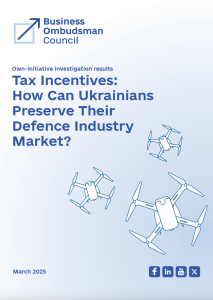- Based on consultation outcomes with industry-specific business, dedicated business associations and civil society representatives, the Council analyzed valued added tax preferential regime balance (“VAT”) in terms of goods supplied for defence needs, as well as separate problems of its administration.
- The first part of this investigation report focuses on the issue of localizing component (parts) production for weapons and military equipment (“WME”) in Ukraine.
- Despite the state’s declared support for defence goods production and its focus on localization, the current tax regime does not favor national weapons and military equipment component manufacturers and makes their products more expensive compared to imported counterparts.
- Tax and Customs Codes were amended in late 2024 to expand tax and customs import benefits on raw materials and supplies for manufacturers of ready-made products, such as drones, electronic warfare systems, etc.
- However, these benefits still do not apply to component manufacturers that, unlike ready-made products manufacturers have to pay import duty and VAT when importing raw materials.
- As a result, ready-made components import becomes more profitable than local production, which in turn slows down Ukrainian component market growth increasing dependence on foreign suppliers.
- This issue is relevant in terms of the goal to gradually reduce Ukraine’s dependence on military equipment imported components, which in the mid- and long-term perspective is likely to minimize budget losses (since import is currently preferential) and can also promote defence capabilities reinforcement and economic development.
- As part of the steps to resolve this problem, the Council proposes the state to explore the local component production market potential; ensure regular audit of current benefits validity; extend benefits for component and not only ready-made products manufacturers and create such benefits appropriate control and reporting application mechanism.
- The second part of the Report deals with separate issues of preferential VAT regime law enforcement and the need for additional clarifications from competent governmental bodies.
- So, we are talking about an exciting number (several dozens in eighteen months) of prosecutor-initiated court cases of charging VAT included in the price of goods from suppliers (both importers and manufacturers supplying military equipment ordered by local self-government authorities, “LGAs”) as unreasonably paid.
- The events sequence resulting in unequal preferential VAT application is the following: the Customers (LGAs) include VAT in the contract price for the Defense Forces; Suppliers accept these conditions; a prosecutor initiates a lawsuit in the interests of local government to the commercial court with a demand from a Supplier for a refund of VAT paid to him by the Customer. The Supplier returns to the Customer a part of funds already paid to the budget and has a cash register gap.
- In some cases, the Supplier acts as a WME importer that imported the goods when their code was not yet included in the commodity codes list to which a preferential VAT regime is applied. In case of benefits application when delivering, the Supplier’s cash register gap becomes even bigger.
- The Council proposes solving these problems in two ways − explanatory and planning. As [art of explanation, the Council sees preparing a generalized tax consultation to cover the question of the end recipient of goods status, end user certificate, tax credit and “compensating obligations” accrual, as well as the status of executors/co-executors of state defence procurement contracts.
- As part of planning, the Council proposes improving analytical approach to expanding or narrowing preferential commodity codes list to include: preferential VAT effectiveness and balance assessment for defence goods; potential business losses assessment when changing the VAT regime for specific goods; forecasting consequences for the state budget; transitional period for benefits application; monitoring business requests for benefits expansion.
- In the third part of the report, the Council looks into the fiscal feasibility and potential impact of VAT taxation regime for military equipment repair and WME modernization services on defence capability.
- Unlike supplying new military pieces of equipment and its some spare parts to the army, repair and modernization services are subject to VAT. It creates financial pressure on the main repair customers − military units and government institutions that are not VAT payers and are forced to pay it as part of the repair price – at the expense of limited budget the state can allocate for repairs. As a result, less pieces of equipment can be repaired for funds allocated by the state, while repair companies lose a part of orders. Therefore, the question arises whether such approach contributes to filling the budget, or creates a “flow” of funds from budget to budget and negatively affects both the industry business and the defence capability.
- In this aspect, the Council proposes the state to investigate the current VAT taxation regime impact on defence financing, namely: to analyze VAT payments financial effect by repairers (VAT volume paid vs. quantity of WME repaired); to partially redirect funds for military equipment repair instead of returning them to the budget; to conduct an audit of cash gaps of repair companies due to funds “freezing” in tax credits and budget payments delays; to determine what % of defence expenses goes to VAT for WME repair and modernization. Following this analysis results, it is proposed to elaborate solutions, a variant of which may be introducing a zero VAT rate on repair/modernization services for military equipment under government contracts or a special taxation regime for such services, which will allow to preserve the current VAT rate (20%), however, the customer will be able to pay the cost of repairs excluding VAT and the repair enterprise – to bill VAT-free invoice, while maintaining tax credit for purchased materials.

